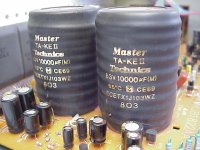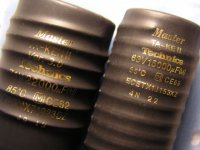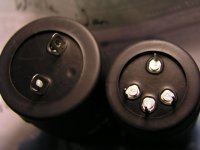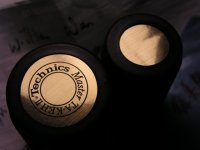I have no idea how long these caps are in production but I encountered them in a Technics amplifier that came in for repair today.
http://www.techtronics.com/files/technics-audiophile-quality.html gives a brief explanation of what the caps pretend to be.
The caps are finished with heat shrinking sleeve to keep the copper coil in place.
Anyone has seen or experienced them or compared them with other caps?
What could be the purpose of the copper coil? As far as I can see it is not electrically connected to anything except with the aluminum housing.
How could bamboo improve the sound?
I would much appreciate the absence of pro and con ‘snake-oil’ posts.
http://www.techtronics.com/files/technics-audiophile-quality.html gives a brief explanation of what the caps pretend to be.
The caps are finished with heat shrinking sleeve to keep the copper coil in place.
Anyone has seen or experienced them or compared them with other caps?
What could be the purpose of the copper coil? As far as I can see it is not electrically connected to anything except with the aluminum housing.
How could bamboo improve the sound?
I would much appreciate the absence of pro and con ‘snake-oil’ posts.
Attachments
Very interesting. I wonder if it's possible to buy them separately or do they always come with a junk amp attached 
Re the bamboo, there seem to have been many attempts to improve the microphonic signature of electrolytic caps. Arguably, the vibrating modes of bamboo are more pleasing than those of a coke can. Haven't you noticed the crazy project replacing the alu can on Elna caps with wood? I have little doubt that these measures work audibly, having only played with skinning caps, but what are the long term reliabilty effects remains unknown.
Is it too much trouble to listen to these caps and compare them to a known entity like Cerafine/BG while you're repairing the amp?
Re the bamboo, there seem to have been many attempts to improve the microphonic signature of electrolytic caps. Arguably, the vibrating modes of bamboo are more pleasing than those of a coke can. Haven't you noticed the crazy project replacing the alu can on Elna caps with wood? I have little doubt that these measures work audibly, having only played with skinning caps, but what are the long term reliabilty effects remains unknown.
Is it too much trouble to listen to these caps and compare them to a known entity like Cerafine/BG while you're repairing the amp?
I can see no reason why they would not be sold separately. Although they are not distributed by Farnell or RS (don’t know of other vendors). I guess I could easily order them at Panasonic.
I did see that website and the utterly time consuming process which had about the same purpose.
I don’t have any Black Gates or Cerafines lying around to test otherwise it would be worthwhile to try it.
What could be done is wind a copper coil around existing normal caps.
Never heard any microphonic effect with caps but I’m willing to believe it exists.
Suppose you connect an amp in one room and the speakers in another room.
Tapping on the caps would then be audible in the speakers. Perhaps it’s a bit more complicated.
I did see that website and the utterly time consuming process which had about the same purpose.
I don’t have any Black Gates or Cerafines lying around to test otherwise it would be worthwhile to try it.
What could be done is wind a copper coil around existing normal caps.
Never heard any microphonic effect with caps but I’m willing to believe it exists.
Suppose you connect an amp in one room and the speakers in another room.
Tapping on the caps would then be audible in the speakers. Perhaps it’s a bit more complicated.
Here are some spare part prices I found, I think thay are for the earlier TA-KE capacitors:
ECETX1J153XZ.......... US$44.56
ECETX1J103XM......... US$34.84
The Technics site in Japan had a page that kinda explained the spiral copper wire, but its either gone or I can't find it.
Check this link
Audiophile Quality TA-KEH II Electrolytic Capacitors
Regards
James
ECETX1J153XZ.......... US$44.56
ECETX1J103XM......... US$34.84
The Technics site in Japan had a page that kinda explained the spiral copper wire, but its either gone or I can't find it.
Check this link
Audiophile Quality TA-KEH II Electrolytic Capacitors
Regards
James
I found a good supply of these caps at a nice price. Similar to the ones in the pic posted by Netlist. However, there are 4 legs, designated as 1,2,3 and negative. anyone can advice on how to connect the cap? 1,2 and 3 in series as positive polarity? Anyone here used them before?
positive polarity
The positive leg is directly opposite the negative leg. The other two is just for support.
The positive leg is directly opposite the negative leg. The other two is just for support.
commstech said:I found a good supply of these caps at a nice price. Similar to the ones in the pic posted by Netlist. However, there are 4 legs, designated as 1,2,3 and negative. anyone can advice on how to connect the cap? 1,2 and 3 in series as positive polarity? Anyone here used them before?
hi,
I had 8 pcs of the best
TA-KEH II ver.3 71V 22000uf code ECEMMX71223DZ.
20 pcs 63V 15000uf ECETXJ153XZ.
38pcs 63V 10000uf same code.
60 pcs 25V 10000uf.
on hand. any diyers had interstest pls email to me. Will very good offer to them. I got them from japan last weeks from one parts store. They clear stocks & I buy all of them,
All were gold words & brand new.
I did not prepare earn any money, only hope to benefit to diyers.
I was a tube lovers. I got them because I know this OFC lead out caps was very good for diyers.
don't miss the chance will much better than Elna, muse & silmic.
Unless U choose backgate, this ver. 3 TA-KEH II capcitors was one of the best master capacitorsin japan.
Will not continous stock later.
thx
thomas
I had 8 pcs of the best
TA-KEH II ver.3 71V 22000uf code ECEMMX71223DZ.
20 pcs 63V 15000uf ECETXJ153XZ.
38pcs 63V 10000uf same code.
60 pcs 25V 10000uf.
on hand. any diyers had interstest pls email to me. Will very good offer to them. I got them from japan last weeks from one parts store. They clear stocks & I buy all of them,
All were gold words & brand new.
I did not prepare earn any money, only hope to benefit to diyers.
I was a tube lovers. I got them because I know this OFC lead out caps was very good for diyers.
don't miss the chance will much better than Elna, muse & silmic.
Unless U choose backgate, this ver. 3 TA-KEH II capcitors was one of the best master capacitorsin japan.
Will not continous stock later.
thx
thomas
Just wanted to mention that ROHS regulations are forcing Japanese manufacturers such as Nichicon, Elna, Nissei, Nippon Chemicon et al to change the composition of their audiophile-grade caps, with the manufacturers explicitly stating that they cannot guarantee that the original sound will be kept.
Many of the non-audio grade caps have already made the transition to ROHS compliance, but the audio-grade caps appear to be lagging (in some cases it takes me weeks to get answers to equivalent parts numbers and lead times).
So if there is a certain cap that you dote on, you may want to stock up on it, because after the existing inventory is gone, the manufacturer may not ever make the same thing again.
hth, jonathan carr
Many of the non-audio grade caps have already made the transition to ROHS compliance, but the audio-grade caps appear to be lagging (in some cases it takes me weeks to get answers to equivalent parts numbers and lead times).
So if there is a certain cap that you dote on, you may want to stock up on it, because after the existing inventory is gone, the manufacturer may not ever make the same thing again.
hth, jonathan carr
hi jcarr,
I understand what U mention. But i was a tube lover. Use tube amp & at least for 450V HV. I bought them because of its price & staff of the shop told me this were the remain stocks of their shop. I also bought some of the X-pro capacitors for the tubes amp. its was 500V 100uf for my SE tube amp. If I brought them together will had 8% discount to me. I thought this caps will good for the transister diyers in this forum. So I bought with them. I bought them not prepare for earn money, only hope to share good parts to more diyers.
Some of the caps nowadays was made in korea, malaysia or china. but this TA-KEH II was made in japan, especially the ver 3.
Japanese diyers love it most but I had only 8 pcs on hand. No more. Sorry for it.
pls saw the caps photos.
thx
thomas
I understand what U mention. But i was a tube lover. Use tube amp & at least for 450V HV. I bought them because of its price & staff of the shop told me this were the remain stocks of their shop. I also bought some of the X-pro capacitors for the tubes amp. its was 500V 100uf for my SE tube amp. If I brought them together will had 8% discount to me. I thought this caps will good for the transister diyers in this forum. So I bought with them. I bought them not prepare for earn money, only hope to share good parts to more diyers.
Some of the caps nowadays was made in korea, malaysia or china. but this TA-KEH II was made in japan, especially the ver 3.
Japanese diyers love it most but I had only 8 pcs on hand. No more. Sorry for it.
pls saw the caps photos.
thx
thomas
Attachments
I think its mostly a issue with high-sensitivity LP-catridge preamps. Line level inputs in 0.7-2v range are highly immune.Netlist said:I
Never heard any microphonic effect with caps but I’m willing to believe it exists.
Connect +60db preamp to line input and any sort of cap connected to preamp input starts to make noise. Polyprops, styrenes, ceramics, all more or less microphonic. Even cables make clearly audible noise when moved or flexed. Hell, I can even hear it if I slide my fingernail over a coaxial cable.
- Status
- This old topic is closed. If you want to reopen this topic, contact a moderator using the "Report Post" button.
- Home
- General Interest
- Everything Else
- Panasonic TA-KEH caps. A new step forward?



